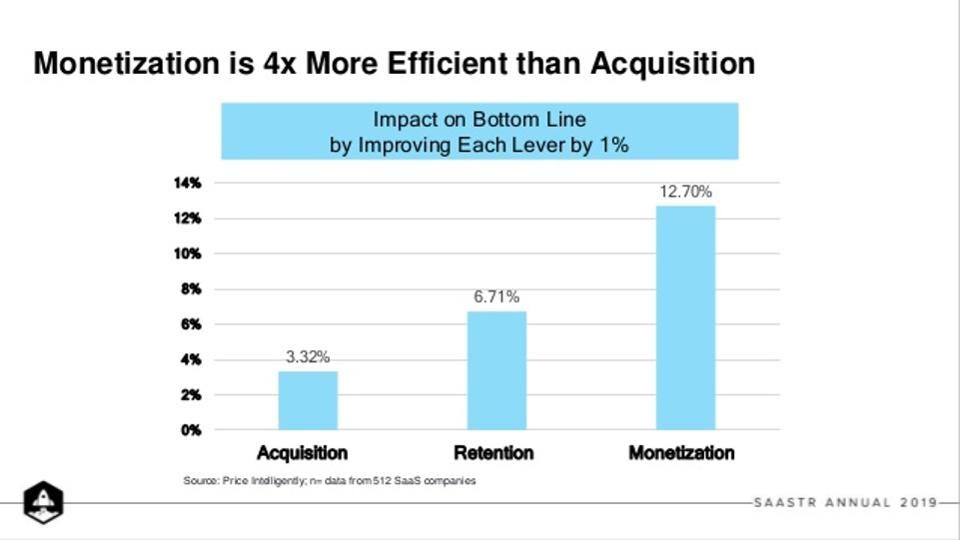
Pricing strategy is one of the most overlooked yet foundational drivers of monetization and growth in a business. Knowing how and when to change your strategy is essential to maximizing your profits, especially now.
Many executives place the onus on themselves to develop a strategy internally, which is often relatively arbitrary, or overly influenced by the pricing of direct competitors in the market.
Figuring out how to price a product can be difficult. Setting prices too high might drive away customers, too low and your costs may exceed the revenue generated. Finding that middle ground comes only from evaluating your environment and your consumers.
When Netflix introduced its online streaming platform in 2008, it was the first of its kind. But with a limited number of titles in its library, it offered two subscription models for customers: a plan with unlimited shows and movies for $9/month or a plan where users could only stream 2 hours of content per month for $5/month. As more titles were added to their online library, Netflix was able to take advantage of this by increasing their prices and segmenting their consumers. New options like Netflix Premium appealed to families who could now stream shows on different screens from the same account.
Software products should constantly evolve to incorporate user feedback — but which users to take feedback from and which represent perspectives from the wrong target audience isn’t always clear. Every bit as important as , whether it be a new feature or an update to the UI. Similarly, we see continuous changes in the market, consumer preferences, and even technological advancements. Therefore, a strategy that worked two years ago may no longer yield the same results. It is essential for businesses to often re-analyze existing strategies and test new ones in order to set or modify prices that will optimize their profits.
How, When, and What you charge should be based entirely on the point of view of the customer, and not the roadmapping or priorities of the internal teams.
Too often, early LTV calculations overlook the pivotal role that freemium users play in driving virality and growth, especially of referrals that occur through word of mouth channels that are difficult to automatically track (social posts, verbal word of mouth, and other online and offline channels outside of the purview of our platform and tracking all fall within this realm).
Identify the Value
It is necessary to understand the value that users derive from the product, including how they quantify the value and when they experience it.
Yet too many companies are quick to jump into a SaaS or subscription model without understanding if the value users envision is outcome-based or Transactional instead.
Are the features you charge most for the ones they receive value from? Do your pricing packages adapt to the considerations and workflows they prioritize? How does your price compare to their willingness to pay? Does the frequency with which you charge line up with when they want to pay? Through surveys and qualitative research, you can determine whether or not the consumer viewpoint aligns with your strategy. Gaps between the two are potential opportunities for improvement or growth.
Optimize Pricing Options
One potential response might be to change existing packages to better align with the most valuable use cases. This is especially useful if your research shows that customer viewpoints do not align with the current strategy or if the cost of serving the use case exceeds the revenue. Some factors to consider may be changing how price scales based on consumer value, re-evaluating what features to charge for, modifying the price itself, or updating the frequency of payments.
If you find that a substantial portion of consumers do not align with the current strategy or if you are looking to broaden your target audience, then introducing a new use case could be another potential strategy. This approach would involve either a vertical or horizontal implementation, depending on what portion of your consumers might value this option. If you find that customers across all use cases might be interested in this or if the cost involved in the new use case is high, then consider taking a horizontal approach. This would add on to each of the existing use cases. However, if only a segmented portion of consumers would benefit from this choice or the cost involved is minimal, then a vertical approach may be a better option. This would mean an entirely new use case, providing consumers with more choices.
Optimization strategies are more consumer focused.
While they do not directly address pricing, they are essential in customer acquisition and retention, which are vital to long term revenue growth. After all, consumers are the basis for any business, and without them, there would be no revenue whatsoever. These strategies target the four customer states: potential customers, existing healthy customers, at-risk customers, and churned customers. Knowing the differences in mentality between these groups of individuals is important when developing unique strategies for each group. Each customer group must be analyzed separately in order to determine how best to optimize. The goal for potential customers, at-risk customers, and churned customers is to convert them into healthy customers by understanding the reasoning behind their mindsets. The goal for existing healthy customers is to bring them on the path to expansion by finding ways to maintain and increase their perceived value. The process for bringing each group to a target state requires educating users on the benefits of the product, converting them by building up the perceived value and decreasing perceived price, and activating them by reinforcing the benefits of the product in order to deter consumers from churning. This three-step process is crucial for converting and maintaining healthy customers.

Place the Bet
Your life will change once you understand that no test or decision will ever have all of the relevant information or quantitative data to be foolproof.
Consider any Q1 2020 strategy. It doesn’t matter how well researched or validated those hypotheses were: black swan events like this pandemic happen. Even in less tumultuous times, shifting competitive landscapes, or governmental tariffs, or nuanced consumer behavior changes are all able to render a strategy obsolete. Understand that you need to make strategic decisions fluidly and methodically, with room to test and iterate, is a winning strategy.
Once a strategy has been chosen, whether it be a model strategy or an optimization strategy, the next step is testing. Although research and customer segmentation are critical in developing an effective strategy, testing is the only way to guarantee its success. Often, companies are hesitant to test new strategies out of fear that their consumers might respond negatively. If only a portion of consumers’ experience increases in price, that might deter them from using the product going forward. In addition, it can take a substantial period of time before a certain strategy’s efficacy becomes apparent.
The most common test is a standard A/B or multivariate test, but these are only valuable for products with enough traffic volume to derive statistical significance. Companies often overlook the negative effects of page performance and load time when adding A/B tests through tools like Optimizely or Google Optimize, and without enough volume, you’ll negatively impact your website performance by a load time of 1–2 seconds, without deriving conclusions from your experiments.
If you fall into this category with under a few thousand page visits per month, consider running more qualitative tests like prototypes or survey feedback to see which offers and visuals users engage with and respond to without impacting your page performance.
With a control group and an experimental group, it is easy to compare results and determine the value and efficiency of a certain strategy. Before starting a test, it is essential to understand what components of the model you are changing and what metrics you plan to use to measure the impact. Success metrics are often consumer focused and deal with factors like conversion rates or consumer behavior. Once your scope and objective have been defined, you can actually build the test. Think about what factors need to be controlled in order to minimize the complexity of the test. Also, consider which group of users to run the experiment on. You want to ensure that your results are valid by choosing a sample that is representative.
In 2015, Klipfolio, a Canadian software dashboard company, developed a new strategy based on the number of features a customer uses rather than the number of users within an account. 30% of trials and new customers were offered the original model and 70% were offered the new model. By the end of the quarter, Klipfolio’s hypothesis was confirmed. They realized that their original pricing model was not optimized for their target audience since it did not offer enough flexibility. Klipfolio measured their success with five different metrics. They looked at conversion rate, the average subscription value of a new customer, the number of users per account, consumer behavior, and long-term consumer response. They found that on average customers were paying more, the number of new users increased, and consumers were more engaged compared to the previous model.
Everything is Iterative
Adjusting your optimal price is an iterative process. Systematically scouring the market for opportunities to re-segment and adapt to changes in consumer behavior is critical to the ongoing success of a pricing strategy. Be open to change.
How To Price Products: Optimizing Your Pricing Strategy As A Growth Lever was originally published in Strategica Partners on Medium, where people are continuing the conversation by highlighting and responding to this story.